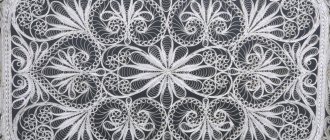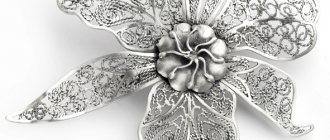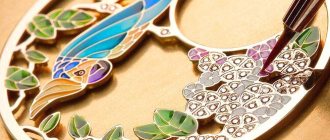Filigree (in Russian - scan , English filigree) is an openwork or wire pattern soldered to metal. And at the same time - a spoon and a glass holder in the buffet of many respectable families. The word “filigree” shows the essence of production: the Latin filum - “thread” and granum - “grain”, and the Russian “filigree” - from the Old Russian “skat” (to twist, twist). Most often, filigree is made of silver, but filigree patterns are also made of gold and other metals. Silver and gold are very soft and can be easily pulled out into very thin wires. The wire for the filigree pattern (silver, less often gold) can be smooth or twisted into ropes and spirals. Filigree was known throughout the ancient world (Crete, Egypt, Troy, Greece VI-IV centuries BC). This is one of the basic, “original” jewelry techniques.
Types of jewelry filigree
Filigree can be soldered, openwork and voluminous. In brazed filigree, wires and grains are soldered directly onto sheet metal. If the background is left, it is background or “blank” filigree. When, after soldering, the background is removed (by notching or sawing), then this is notched or sawn filigree. In embossed relief filigree, the pattern is soldered onto the embossed relief. In openwork filigree there is no metal base: the wire pattern is soldered on itself, and the grain is attached directly to the metal lace. If the “lace” is flat, then it is flat openwork filigree. If the lace is soldered in two dimensions and is voluminous (three-dimensional relief or high relief), then it is sculptural-relief openwork filigree.
“Russian filigree” in foreign sources . Volumetric filigree - cups, vases, trays, caskets and buildings, and even creatures - birds, animals.
It is created in parts and then assembled into a single composition. In jewelry they use both flat (frame pendants), and openwork-volume (hemispherical complex brooches and rings, link and “solid” bracelets), and sculptural (animals, birds, bells) openwork filigree made of silver and other metals.
Who owns the filigree technique?
It would be a mistake to consider that filigree is a purely Russian craft. The traditions of filigree art are alive in modern schools in different countries. The filigree of Armenia is subtlety and flatness, of Dagestan - an abundance of grains and hemispheres, of Kostroma - complex volumetric shapes. Products using the filigree technique are produced by jewelers from various countries - France, Italy... Painfully familiar silver openwork patterns can unexpectedly be found in jewelry, for example, from Ecuador. And you shouldn’t be surprised by this, because it is in Latin America that ancient “silver” crafts, including filigree, are especially alive.
Examples of Ecuadorian filigree jewelry:
What you need to work with jute
The necessary materials and tools can be purchased at any hardware store.
The table shows a list of accessories for working with filigree:
| Making products using the jute filigree method | |
| Materials | Tools |
|
|
How is filigree jewelry made?
Elements of a filigree pattern are rope, cord, weaving, herringbone, track, satin stitch, and so on. It is essentially a lace appliqué made from metallic thread. Filigree is often combined with granulation - small balls that are soldered into prepared cells (recesses). The grain gives filigree a particularly elegant, sophisticated look. The materials for the products are alloys of gold, silver and platinum, as well as copper, brass, cupronickel, and nickel silver. The filigree technique can be used to make all types of jewelry without exception.
Silver filigree and more - manufacturing technology
A master scanner (who worked in royal or monastic workshops) worked along the entire “chain” of the process, from conception to completion of the product.
In modern jewelry production, of course, division of labor has long been used, but the technology for creating filigree jewelry itself has changed little. What does filigree production technology look like? In general, to “type a filigree”, you first need to bend the details of the design, and then install, adjust, and glue them in place. It is more convenient to prepare all the elements of the design, and only then secure them in place. Elements of the filigree pattern are bent using tweezers - forceps. Its ends are pointed and capture the thinnest “scans”. The curved parts of the future scan are laid out on paper with a pattern already applied and the set is carried out in the same way as on sheet metal (in the case of a background scan). The density of the set is “extremely important” - the “curls” are soldered only to each other, the background is “no help” for them. If the set is loose, the openwork filigree “crumbles,” which means secondary insertion and soldering. When soldering, the paper with the pattern applied burns, and the curls are soldered together, forming a durable patterned lace. The final stage of filigree manufacturing technology includes silver plating of the product with 999.9 anode silver. Aging is carried out by oxidation.
How was the filigree “tempered”? The history of the heyday of filigree
In the 17th century, the demand for filigree jewelry grew. In the 18th century, serious filigree items were created; along with stones, crystal and mother-of-pearl were used. Little joys are not forgotten either - vases, salt shakers, boxes. Since the nineteenth century, filigree has become a manufactured product. The technology is being honed, relief openwork filigree is blooming, and translucent stained glass is appearing - openwork filigree with transparent enamel. Having experienced decline at the beginning of the twentieth century, filigree jewelry techniques have regained strength since the middle of the century. In 1937, the works of craftsmen from the village of Krasnoe-on-Volga ( "Krasnoselsky Handicraftsman" , near Kostroma) were shown at the World Exhibition in Paris, where they took gold for filigree brooches, boxes and other accessories, and in 1939 - in New York . They also took up filigree in the village of Kazachkovo (Vachsky district of the Nizhny Novgorod region).
Kazakovskaya filigree – modern production
Today, the Kazakovsky Art Products Enterprise (KPHI) is a serious “filigree” brand (website kphi.rf), specializing specifically in products using this technique. KPHI brand jewelry is usually made of silver-plated alloy.
What distinguishes Kazakovskaya filigree? When composing a pattern, the master monitors the harmony of its individual parts, the beauty of the lines of large and small elements. The artist also works on the design of the gaps: this is extremely important in constructing the pattern. The charm of Cossack products lies in their openwork - filigree as an end in itself. The KPHI website has spread a filigree web of powerful temptation.
Lures are varied: filigree dishes - for reasonable housewives; for hipsters - filigree flash drives; to the ruling authorities - kits for the consumption of alcohol and tobacco. Women's jewelry is not forgotten either - it is spectacular and elegant at the same time. “Slavyanka” jewelry combines fidelity to style with originality and purity of finish. The lack of inserts softens the price.
Examples of products from Kazakovskaya filigree (KPHI):
Filigree from "Kubachi"
Kubachi jewelers (kubachi.su), along with the traditionally famous Dagestan technique of blackening, chasing and engraving, also produce filigree items of incredible beauty.
Examples of filigree work by Kubachi jewelers:
Basic weaving techniques for beginners
It is recommended to start creativity by studying simple basic elements, learning how to make different types of loops, curls, leaves, snails. A frequently used element is the loop. It can be empty in the center or filled with thread patterns. The loop can have a rounded, sharp or peaked top.
Another important skill that a beginner needs to master is making jute ribbons glued together from several threads. To do this, apply glue to the oilcloth with a length equal to the length of the cut threads, distribute it using a toothpick and apply the threads (usually 3 pieces) tightly to each other.
Without allowing the glue to dry, the workpiece is separated from the film and carefully smoothed with your fingers along the entire length from start to finish. After drying, the tape becomes dense and elastic.
Jute filigree and its easy-to-make elements allow you to create any products, the designs for which you can make yourself, using your imagination, tips from books or the Internet.
Where can you buy real filigree jewelry?
Unfortunately, finding true filigree is not so easy. Not all jewelry enterprises (and KPHI is a typical example) disclose on their websites the names of retail chains with which they cooperate to sell products. As a result, you can completely accidentally “come across” scanned items by simply going to a regular jewelry store near your home - with the same success as not finding it at all, having walked around a dozen stores.
One of the more reliable ways today is to attend jewelry exhibitions, which are regularly held in Moscow and other large cities (jewelry exhibition calendars). More or less serious jewelry companies from different parts of the country are represented there, making jewelry using a wide variety of techniques. And you can even meet those manufacturers who do not sell through stores at all, whose assortment can be seen exclusively at exhibitions.
If you wish, you can also try searching for filigree products made in different countries (including eastern ones - Nepal, Thailand) in online stores, as well as on the websites of private jewelers, websites for collectors, or foreign stores or hand-made resources like etsy.com. On the latter you can find beautiful antique specimens.
As we find manufacturers and retailers offering real filigree, we will add them to our Manufacturer Directory and Seller Directory, where you can find them by specifying your search parameters.
Products with “filigree elements” versus “true filigree”
Jewelry almost always contains filigree elements: a scattering of beads of grain, a cord or rope of metal around an insert with a stone or pearl. Sometimes filigree curls and grains are soldered onto cast or stamped parts of the jewelry. On the one hand, this is no longer completely filigree and not purely handmade. But such “combi-filigree” is often stronger, cheaper and more accessible than its noble “cousin” - pure hand-made filigree.
The balance of aesthetics and practicality will give the buyer the desired vector. Let's say the strength of the earlobe is not limitless. And your goal is voluminous earrings or a pendant. In openwork hand-made filigree, the ratio of dimensions to weight is the most humane, perhaps this is “to your advantage” (to your ears). Bracelets and rings may require greater strength, and then “mixed” filigree will seem “stronger” than filigree. The main thing, as always, is to understand the difference between true filigree and its imitation, consciously giving money for this or that product.
For comparison: on the left is a ring with “filigree elements”, on the right is a filigree bracelet
Russian craft
Filigree in Ancient Rus' is a kind of calling card of original Russian jewelry art. This technique was widely used to make not only jewelry, but also church utensils, frames for sacred books and icons, weapons, and household items. For example, even morocco boots were decorated with filigree.
In the 17th century, special workshops were opened in Rus' in which they were engaged in the manufacture of wire (drawing). And at the monasteries, in the princely estates, workshops were opened in which real talents of filigree work worked. Chronicle sources name Ivan Fomin and Ambrose as the most famous masters of those times.
Filigree are very expensive products that were available only to rich people. After all, it was delicate manual work, requiring the master to have accumulated years of experience, which contained the secrets of mastery.
How to wear filigree jewelry: our recommendations
Wearing filigree requires an approach: its “lace” requires a contrasting background, stylistic unity with clothing. Light filigree looks luxurious on dark skin, looks clear against the background of dark hair, and goes well with a dark manicure. Blackened filigree is especially effective on pale skin, or with pastel-colored clothing. In a word, any contrast - color, graphic or texture (we mean smooth fabrics: satin, satin, etc.) will “reveal” a filigree product. And if everything is taken into account, then know: wearing filigree, you will not get lost in the crowd.
JEWELRY MAKING | Jewelry techniques - types Jewelry with enamel | Hot and cold enamel technique | Cloisonné technique | Georgian cloisonne enamel | Rostov enamel
Metal chasing. Metal engraving technique. Embossing on metal Blackening of gold and silver. Northern blackening plant - blackening classics | Metal etching. Chemical gilding. Silvering of jewelry. Oxidation, and other coatings | Chainmail weaving and its types
Share this article with your friends
Works by designers from the JEWELIRUM catalog
- Co.Cos Jewelry
- Co.Cos Jewelry
- Taiga Jewelry, Tomsk
- Taiga Jewelry, Tomsk
- Ilya Maksimov, Crimea
- Ilya Maksimov, Crimea
- UBIRING
- UBIRING
- Diamonds are Forever
- Diamonds are Forever
- Rings in natural style, Sergacheva Jewelery
- Earrings with pearls, Sergacheva Jewelery
- Cabochon ring, Minty Sky
- Fly earrings, Minty Sky
- Ring, Precious Park
- Ring, Precious Park
- Snake skin ring, Stoyanova Jewelery
- Chain earrings, Stoyanova Jewelery
- Children's pendant - stick, Matthew&Daniel
- Pendant for a child, Matthew&Daniel
- Bracelet, Svetlana Subbotina
- Ring with Slavic symbols, Svetlana Subbotina
- Indian style ring, Anna Goffman
- Indian style ring, Anna Goffman
- Earrings, ISTA
- Geometric ring, ISTA
- Earrings with enamel, PNJewelry
- Ring with enamel, PNJewelry
- Ring, Khramtsova Jewelry
- Ring, Khramtsova Jewelry
- Wedding rings to order, obruchalki.com
- Wedding rings to order, obruchalki.com
- Earrings, Yuri Bylkov
- Earrings, Yuri Bylkov
- Titanium bracelets, LanaMuransky
- Titanium pendant, LanaMuransky
- Brooch Elephant (after Salvador Dali), THING
- Ring Veil, THING
- Mace earrings, VLADIMIR MARKIN
- Cufflinks, jewelry mechanics, VLADIMIR MARKIN
- Drop-shaped ring, EKATERINA TOLSTAYA
- Drop-shaped earrings, EKATERINA TOLSTAYA
- Necklace with amber, LETA
- Earrings with amber, LETA
- Children's earrings, combinable, FASHBY
- Children's earrings, combinable, FASHBY
- Ring of architectural form, Elizaveta Malafeevskaya MANU_L
- Architectural bracelet, Elizaveta Malafeevskaya MANU_L
- Set Ginkgo Leaf, SHABUT JEWELLERY
- Brooch Wearable porcelain, SHABUT JEWELLERY
- Architectural ring, GEOMETRY
- Brooch, porcelain, GEOMETRY
- Necklace made of polymer clay, LICORNE ART
- Brooch made of polymer clay, LICORNE ART
- Ring, avant-garde, VALERY SEREDIN
- Bracelet, avant-garde. VALERY SEREDIN
- Wooden set, Scandinavian/Japanese minimalism, VLADIMIR SHESTAKOV
- Ring, Scandinavian/Japanese minimalism, VLADIMIR SHESTAKOV
- Earrings, TON ANT
- Ring, TON ANT
- Architectural ring, ANCHOR
- Architectural necklace, ANCHOR
- Earrings, GOHFELD JEWELLERY
- Necklace, GOHFELD JEWELLERY
- Massive ring, YAKISCHIK
- Designer jewelry, YAKISCHIK
- Architectural ring, ONE DAY ART
- Architectural ring, ONE DAY ART
- Brooch, bionics, VALERIYA MARKOVA (TESSA)
- Unclosed ring, bionics, VALERIYA MARKOVA (TESSA)
- Ring, bionics, BEAVERS
- Earrings, bionics, BEAVERS
- Earrings, asymmetry, VAGANOVA JEWELRY
- Airplane ring, VAGANOVA JEWELRY
- Flower ring, ALCHEMIA JEWELLERY
- Set, ALCHEMIA JEWELLERY
- Pendant-cat, ethnic, STUDIO OF ILYA AND VERA PALKIN
- Earrings, STUDIO OF ILYA AND VERA PALKIN
Comments
- Natalia
help me find a jeweler who works in filigree technique. I want to order a bracelet in the style of ancient oriental filigree. Thank you
7 years ago Reply
- juvelirum
Natalya, good afternoon! Unfortunately, we personally don’t know any jewelers who specialize in filigree or filigree. Try asking a question on jewelry forums or go to the nearest jewelry exhibition, where there are usually many craftsmen (exhibition schedule:)
7 years ago Reply
- Emma
in the Altai Republic, Ongudai district from Kupchegen, there is a workshop there that makes a lot of beautiful handicrafts from leather, iron, wool, felt, including filigree.
6 years ago Reply
- Ilyas
I am a jeweler artist, write to me.
5 years ago Reply
I make jewelry using the filigani technique, I have experience, +79821025673
4 years ago Reply









